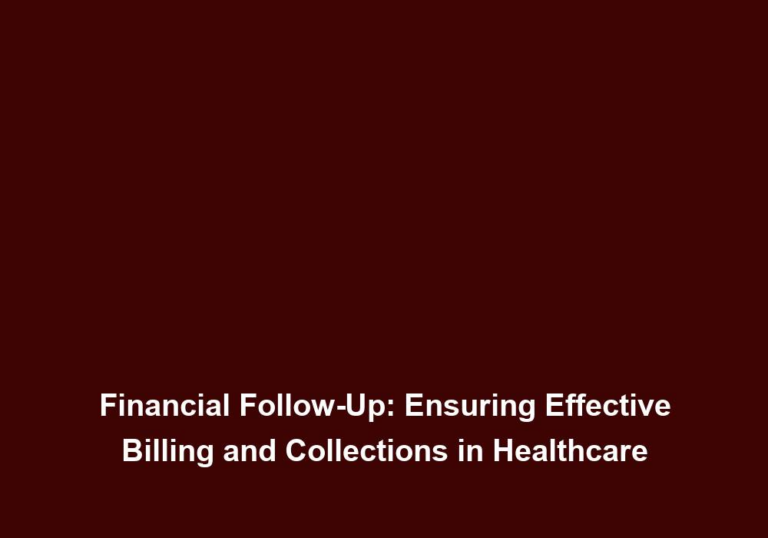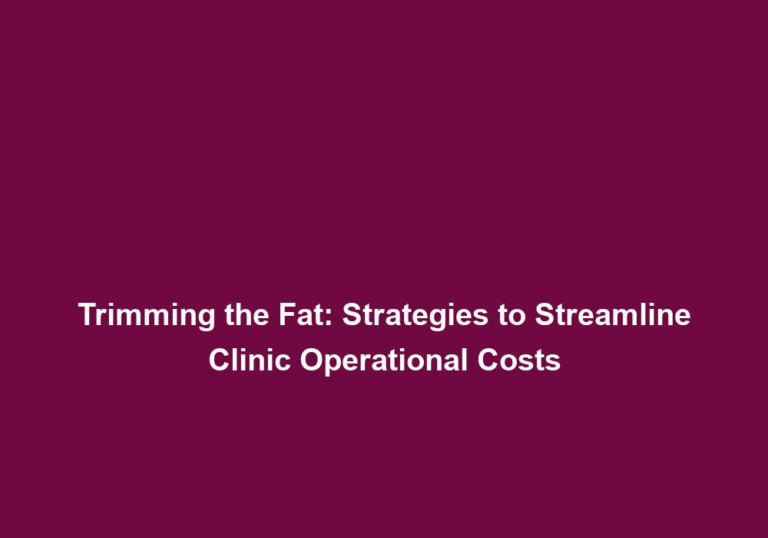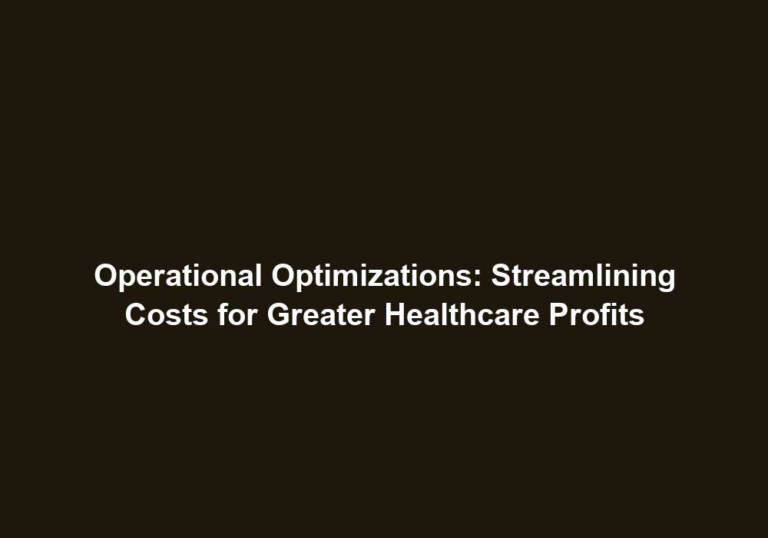Financial Foresight: Mastering Budgeting and Forecasting for Clinics
In today’s rapidly changing healthcare industry, clinics must possess accurate financial foresight to effectively manage their budgets and make informed decisions. Budgeting and forecasting play a crucial role in ensuring financial stability and growth for clinics, allowing them to allocate resources efficiently, plan for the future, and adapt to market dynamics. This article will delve into the essential aspects of mastering budgeting and forecasting for clinics, providing valuable insights and actionable strategies.
Importance of Budgeting and Forecasting in Clinic Management
1. Financial Stability and Growth
Budgeting and forecasting serve as the backbone of financial stability and growth for clinics. By creating a comprehensive budget, clinics can identify their revenue sources, expenses, and potential cost-cutting measures. This allows them to ensure that their revenue exceeds expenses, paving the way for sustainable growth and increased profitability.
Furthermore, forecasting helps clinics anticipate future trends, potential challenges, and opportunities, enabling them to make proactive financial decisions. By analyzing historical financial data and market trends, clinics can accurately project their financial outcomes and make necessary adjustments to optimize their financial performance. This not only ensures stability but also positions the clinic for long-term growth and success.
To expand on this topic, let’s consider some additional points:
- Budgeting allows clinics to set financial goals and monitor their progress towards achieving them.
- Forecasting enables clinics to identify potential risks and develop contingency plans to mitigate them.
- By regularly reviewing the budget and forecast, clinics can adapt to changing circumstances and make necessary adjustments.
2. Resource Allocation Efficiency
Effective budgeting and forecasting help clinics allocate their resources efficiently. By analyzing historical financial data and market trends, clinics can identify areas that require increased investment and those that can be optimized.
For example, clinics can analyze patient volume data to determine if there is a need for additional staff members or if there are opportunities to streamline operations. By allocating resources optimally, clinics can enhance productivity, minimize waste, and maximize their return on investment.
To further elaborate on this point, consider the following:
- Budgeting and forecasting enable clinics to identify areas where resources can be reallocated to achieve better results.
- By analyzing historical data on expenses, clinics can identify cost-saving opportunities without compromising the quality of care.
- Effective resource allocation helps clinics make strategic decisions regarding staffing, equipment purchases, marketing initiatives, and other crucial aspects of their operations.
3. Planning for the Future
Budgeting and forecasting empower clinics to plan for the future with confidence. By projecting financial outcomes based on different scenarios and assumptions, clinics can identify potential risks and develop contingency plans. This forward-thinking approach enables clinics to navigate uncertainties, adapt to changing market dynamics, and seize emerging opportunities.
Additionally, budgeting and forecasting facilitate strategic decision-making, such as expansion plans or investment in new services, ensuring long-term sustainability and growth. By aligning their financial goals with the evolving needs and circumstances of the clinic, clinics can position themselves for success in an ever-evolving healthcare landscape.
To expand on the importance of planning for the future, consider the following points:
- Budgeting and forecasting help clinics identify opportunities for growth and expansion.
- By projecting financial outcomes, clinics can evaluate the feasibility of new initiatives and make informed investment decisions.
- Planning for the future allows clinics to anticipate changes in the healthcare landscape and adapt their strategies accordingly.
Essential Steps for Effective Budgeting and Forecasting in Clinics
1. Gather and Analyze Historical Data
To establish a solid foundation for budgeting and forecasting, clinics must gather and analyze historical financial data. This includes revenue, expenses, patient volume, and other relevant metrics over a defined period. Analyzing this data helps identify patterns, trends, and seasonal fluctuations, providing valuable insights for future budgeting and forecasting.
Clinics can leverage financial software or tools to streamline this process and gain more accurate and up-to-date information. By utilizing technology, clinics can automate data collection and analysis, saving time and improving the accuracy of their financial insights.
To further enhance the gathering and analysis of historical data, consider the following points:
- Clinics should consider both internal and external factors that may impact their financial performance.
- By comparing data from different time periods, clinics can identify long-term trends and make more accurate forecasts.
- Using financial software or tools allows clinics to generate visual representations of the data, making it easier to identify patterns and trends.
2. Identify Key Revenue Streams and Expenses
Clinics need to identify their key revenue streams and expenses to develop an effective budgeting and forecasting strategy. Revenue streams can include patient consultations, diagnostic tests, procedures, or other services provided. On the expense side, clinics should consider personnel costs, rent, utilities, medical supplies, and other operating expenses.
Accurately mapping out these revenue streams and expenses enables clinics to allocate resources appropriately and set realistic financial goals. By understanding the primary sources of revenue and the major expenses, clinics can make informed decisions about resource allocation and identify areas where cost-saving measures can be implemented.
To provide further insights into this step, consider the following:
- Clinics should analyze revenue streams to identify the most profitable services and explore opportunities for growth.
- By categorizing expenses, clinics can identify areas where cost-cutting measures can be implemented without compromising patient care.
- Understanding the key revenue streams and expenses helps clinics set realistic financial goals and measure their performance against them.
3. Establish Realistic Budget Goals
Based on the historical data and a thorough understanding of revenue streams and expenses, clinics should establish realistic budget goals. These goals should be specific, measurable, achievable, relevant, and time-bound (SMART).
By setting SMART goals, clinics can track their progress, identify areas of improvement, and make necessary adjustments to achieve their financial targets. Regularly reviewing and adjusting the budget goals is crucial to ensure they align with the evolving needs and circumstances of the clinic. It is important to note that budget goals should be flexible enough to accommodate changes in the healthcare landscape.
To elaborate on this step, consider the following:
- SMART goals provide clinics with a clear roadmap for achieving their financial objectives.
- Regularly reviewing and adjusting the budget goals helps clinics stay on track and adapt to changes in the market.
- Establishing realistic budget goals ensures that clinics maintain financial stability while pursuing growth opportunities.
4. Monitor and Control Expenses
Budgeting and forecasting are not just about revenue; they also involve controlling expenses. Clinics should regularly monitor their expenses and compare them against the budgeted amounts.
This helps identify any discrepancies, unnecessary expenditures, or areas where cost-cutting measures can be implemented. By actively managing and controlling expenses, clinics can optimize their financial resources and reduce the risk of overspending. This step requires ongoing monitoring and analysis to ensure that the clinic’s financial performance remains on track.
To provide additional guidance on monitoring and controlling expenses, consider the following:
- Clinics should establish a system for tracking expenses and regularly review financial reports to identify areas of concern.
- By conducting regular expense audits, clinics can identify opportunities for cost savings and implement necessary adjustments.
- Managing expenses effectively requires collaboration between the financial team and other departments within the clinic to ensure compliance and accountability.
5. Embrace Technology and Automation
In today’s digital era, clinics can leverage technology and automation to streamline their budgeting and forecasting processes. Financial management software, spreadsheet tools, and analytical platforms can help clinics access real-time financial data, generate accurate forecasts, and simplify the budgeting process.
Automation eliminates manual errors, saves time, and improves the efficiency of financial tasks. By embracing technology, clinics can enhance the accuracy and effectiveness of their budgeting and forecasting practices.
To elaborate on the role of technology and automation, consider the following:
- Financial management software allows clinics to centralize their financial data, making it easier to analyze and track performance.
- Spreadsheet tools provide clinics with the flexibility to create and update budgets and forecasts as needed.
- Analytical platforms offer advanced data analysis capabilities, allowing clinics to gain deeper insights into their financial performance.
6. Regularly Review and Update Forecasts
Forecasts should not be considered static; they require regular review and updating. Clinics should revisit their forecasts periodically, considering new market trends, regulatory changes, and internal developments.
By staying updated and adapting their forecasts accordingly, clinics can make proactive financial decisions and seize emerging opportunities. Regular review also allows clinics to identify potential risks and take necessary measures to mitigate them.
To emphasize the importance of regularly reviewing and updating forecasts, consider the following:
- Changes in the healthcare landscape can have a significant impact on the clinic’s financial performance, making regular review essential.
- By updating forecasts, clinics can identify potential risks and adjust their strategies to mitigate them.
- Regular review and updating of forecasts enable clinics to stay agile and respond effectively to changes in the market.
Conclusion
Mastering budgeting and forecasting is paramount for clinics aiming to achieve financial stability, growth, and success. By following the essential steps outlined in this article, clinics can develop effective budgeting and forecasting strategies to optimize resource allocation, anticipate future challenges, and make informed financial decisions.
Embracing technology, analyzing historical data, setting realistic goals, and actively managing expenses are just a few of the crucial aspects to consider. By prioritizing financial foresight, clinics can position themselves for long-term success in an ever-evolving healthcare landscape.







